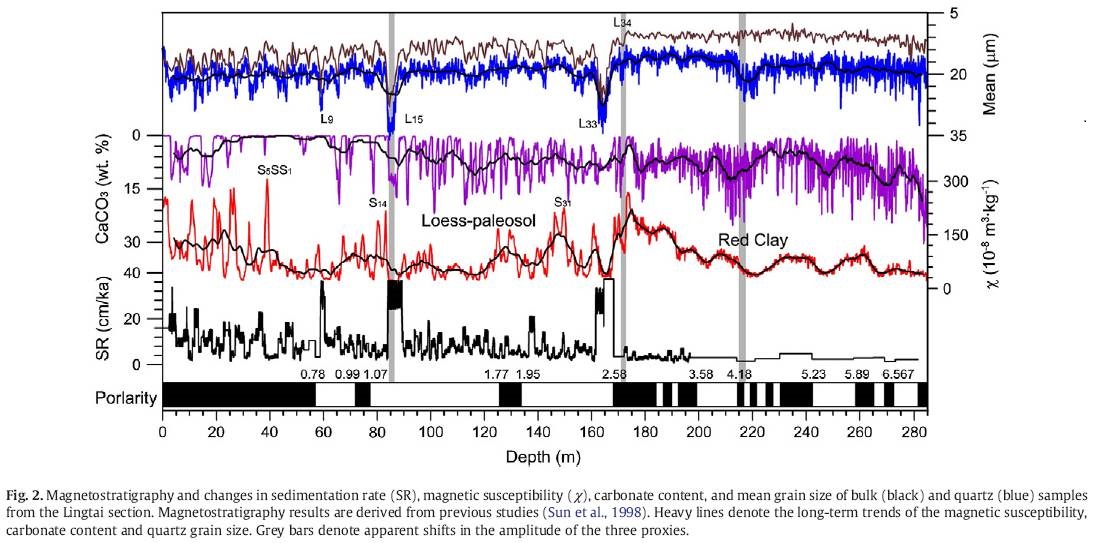Lingtai loess magnetic susceptibility, grain size, and carbonate dataset (over the past 7 Ma)
Clicks:1171
|
DOI
|
|
|
Key words
|
magnetic susceptibility, grain size, carbonate, lingtai
|
|
Related data
|
Recent studies of the eolian deposits in northern China have extended the East Asian monsoon history back to the early Miocene. However, the relative intensities of monsoonal winds and precipitation and the extent of their coupling prior to the Pleistocene epoch remain poorly constrained, mainly due to uncertainties in the interpretation of proxy indices generated from the Mio-Pliocene Red Clay sequences. Here we reconstruct East Asian monsoon oscillations over the past 7 Ma using magnetic susceptibility and carbonate content as summer monsoon (precipitation) proxies, and quartz grain size as a winter monsoon (wind intensity) index. Our results suggest that precipitation and wind intensity exhibited significant orbital-scale variations prior to 4.2 Ma, followed by slightly damped variability between 4.2 and 2.75 Ma. Subsequently, East Asian monsoon circulation experienced two large shifts at about 2.75 and 1.25 Ma, characterized by stepwise strengthening of glacial wind and interglacial precipitation. A remarkable change in East Asian monsoon seasonality occurred around 3.15-2.75 Ma. Prior to 3.15 Ma, strong winds were positively correlated with high effective precipitation, whereas after 2.75 Ma strong winds were negatively correlated with heavy precipitation. This shift was probably induced by a change from an insolation-forced system to one strongly influenced by the combined effects of the phased uplift of the Himalaya-Tibetan Plateau and the simultaneous development of the Northern Hemisphere ice sheets.
|
|
Data description
|
a. Description of Intellectual Property Rights
When using a dataset, please refer to the following documents in the article:
Sun, Y.B., Z.S. An, S.C. Clemens, J. Bloemendal, and J. Vandenberghe. 2010. Seven million years of wind and precipitation variability on the Chinese Loess Plateau. Earth and Planetary Science Letters, Vol. 297, pp.525-535. doi:10.1016/j.epsl.2010.07.004
b. The data labels refer to the following specifications:
Data sources refer to the following specifications:
Chinese Expression:
国家科技基础条件平台-国家地球系统科学数据共享服务平台(http://www.geodata.cn)-东亚古环境科学数据库(http://paleodata.ieecas.cn/index.aspx);
English Expression:
East Asian Paleoenvironmental Science Database (http://paleodata.ieecas.cn/index.aspx),National Earth System Science Data Sharing Infrastructure, National Science & Technology Infrastructure of China (http://www.geodata.cn).
Acknowledgments refer to the following specifications:
Acknowledgments in Chinese:
感谢国家科技基础条件平台-国家地球系统科学数据共享服务平台(http://www.geodata.cn)-东亚古环境科学数据库(http://paleodata.ieecas.cn/index.aspx)提供数据支撑。
Acknowledgments in English:
Acknowledgement for the data support from “East Asian Paleoenvironmental Science Database (http://paleodata.ieecas.cn/index.aspx),National Earth System Science Data Sharing Infrastructure, National Science & Technology Infrastructure of China. (http://www.geodata.cn)”.
c. Contacts
Name: Data processing group
Company: Institute of Earth Environment, Chinese Academy of Sciences
Tel: 029-62336213
Email: eapsd@ieecas.cn
|
|
Dataset format
|
excel
|
|
Data type
|
Aeolian and lacustrine sediments/Aeolian sediments/Aeolian sediments
|
|
Data sources
|
NOAA and authors
|
|
Enclosure
|
[download]
|
|
Related pictures
|
 
|
 Contact card Contact card |
 |
Name:谭婷丹 |
E-mail:1143712055@qq.com |
| Company:西安市雁塔区雁翔路 |
Telephone:18792969062 |